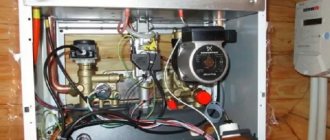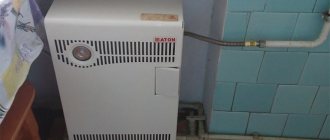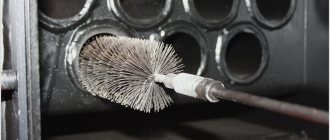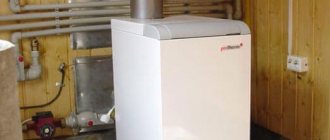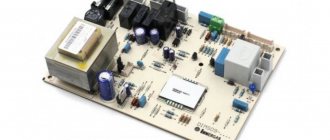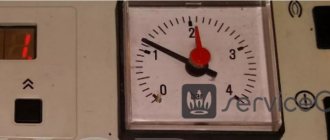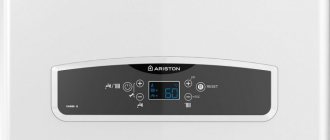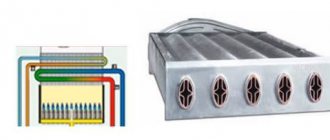Piping a gas boiler in the heating system
After the wall-mounted gas boiler has been installed and the heating device is placed on the wall, the first thing you need to do is connect it to the heating system. Depending on which model is installed, single-circuit or double-circuit, there are different piping schemes. We will look at the connection process using the example of a wall-mounted double-circuit gas boiler.
As you know, a double-circuit boiler, in addition to heating, is capable of producing hot water for household needs. Structurally, this is realized by installing one bithermal or two separate heat exchangers. A double-circuit boiler does not produce very much hot water, but it is quite enough for 1-2 distribution points (for example, a kitchen faucet and shower).
A modern wall-mounted gas boiler is very compact and already contains within itself the basic elements necessary for the operation of a heating system with forced circulation, such as: a circulation pump, an expansion tank, a safety group. In the heating systems of small private country houses, this is more than enough, but if necessary, you can install an additional expansion tank or another pump.
At the bottom of any mounted double-circuit boiler there are 5 pipes. They are connected to: supply and return lines of the heating system, supply and return of hot water supply, main gas. The gas connection is usually located in the center and is colored yellow. All other lines can be located in any order, depending on the model of the gas boiler. Therefore, before starting tying, it is necessary to clarify the purpose of each of them in the operating instructions.
The piping of a wall-mounted gas boiler is done with polypropylene or metal pipes. The cross-section of heating pipes is usually larger than DHW pipes 3/4 and 1/2 inches, respectively. The heating system is connected to the boiler through American nuts. Ball valves are installed on each line for the convenience of dismantling the gas boiler without draining the coolant and to isolate the boiler from the heating system if necessary. To ensure tightness, all connections must be made using plumbing FUM tape or flax.
Coarse filters must be installed in the heating return line and in the DHW supply line. For ease of washing and cleaning, they are also cut off by shut-off valves. Often, in order to increase the service life of the secondary heat exchanger of a double-circuit boiler, a magnetic fine filter is additionally installed at the DHW supply.
Requirements and standards
Installation of systems for heating and hot water supply is permitted only in accordance with the requirements and standards of SNiP, which can be freely found on the Rostekhnadzor website. These standards will differ in some respects from each other depending on the type of boiler and the type of fuel used to heat it, which is described in detail in SNiP 42-01-2002. Before starting work, it is necessary to make a design of such a room and the entire system as a whole in order to get it approved by the following supervisory authorities:
- technical supervision service for gas equipment;
- fire safety inspection;
- sanitary-epidemiological station;
- local housing and communal services authority;
- department of architecture of a region or city.
Only after approval from each authority will permission be given to install boiler equipment and connect gas to it. Not only the procedure for installing equipment, but also the arrangement of the premises itself is subject to approval. There are general requirements and standards that must be taken into account when arranging a boiler room.
To the premises
Let's consider the requirements that are put forward for the premises.
- In the boiler room, the ceiling should be no lower than 2.5 meters.
- The room must have ventilation and a chimney leading to the street. Their height and parameters must be selected based on the power of the boiler and the total volume of the room.
- The boiler room must have at least one window so that there is an additional hood if necessary.
- If a gas boiler is installed in the boiler room, then the entrance to it must be separate. It is necessary to install a door with bars and sheathe it from the inside, and it should only open outwards. The insulated door block is made only from certified fire-resistant materials.
- The walls of the room for installing the boiler and boiler are made of brick or concrete. Wall finishing can be done using special mineral plaster. It is allowed to lay tiles on walls and floors; they can be any color. When decorating a boiler room, you must remember that oil paint is prohibited.
- The floor of the boiler room is always made of concrete; metal sheets or tiles can be laid on top of it. The main thing is that the materials are non-flammable.
To equipment
There are also certain requirements here:
- boilers and the boiler should be located in the boiler room, without touching the walls; this equipment must be freely accessible from all sides;
- no more than two boilers are allowed in one boiler room;
- the total power of the system responsible for supplying heating and hot water should not exceed 350 kW;
- A laundry room cannot be organized inside the boiler room; all washing machines and dryers should be located in another place;
- electrical wiring must be in protective cable ducts made of metal;
- lamps must be covered with a metal mesh housing.
Electrical connection of a gas device
Modern gas boilers have two options for connecting to the electrical network: a three-core insulated cable and a plug for connecting to a socket. In both cases, you should adhere to the rule: the gas device is connected through an individual circuit breaker to the switchboard and you will definitely need to take care of grounding. It is recommended to use voltage stabilizers as well as backup power supplies to prepare for a power outage.
The circuit breaker should be installed near the boiler so that it can be turned off quickly and easily. Do not ground the device to a heating pipe or gas pipeline. In order to ensure high-quality grounding, it is necessary to equip a grounding loop or point grounding.
Connecting a wall-mounted boiler to the electrical network
Most modern wall-mounted gas boilers are equipped with sophisticated automation. It controls many processes, turning the heating boiler into an autonomous mini-boiler room, the operation of which requires virtually no intervention from the owner. Obviously, the control unit and various sensors require an electrical connection.
Double-circuit wall-mounted boilers are available in two versions: with a conventional socket and with a cable for connecting directly to the machine. In any case, they must be powered from the mains through an individual machine. If you purchased a model with a plug, then the individual socket for the gas boiler should be located next to it, but in no case under it. This is one of the safety requirements so that in the event of a coolant leak, a short circuit does not occur.
A gas boiler requires mandatory grounding. For these purposes, you can purchase a point grounding kit. It is installed in the basement or next to the house and occupies a small area of about 0.25 m².
Attention! Grounding a wall-mounted gas boiler to a heating radiator or gas supply pipe is strictly prohibited. This is a gross violation of the rules for operating gas equipment and is extremely dangerous.
Boiler automation is very sensitive to the quality of the supply voltage. If the level of the sinusoid at the input is insufficient or the shape is not ideal, the devices quickly fail. To prevent frequent breakdowns and extend the service life of the unit, it is necessary to connect voltage stabilizers for gas boilers. To avoid shutdowns of heating equipment in the event of power outages, you should additionally purchase an uninterruptible power supply.
How to connect a gas double-circuit boiler
A double-circuit device differs from a single-circuit device in that it contains 2 heat exchangers: one is the main one, which heats the water for heating, and the other is an additional one, which will heat the water for hot water supply. In most cases, such boilers are wall-mounted and represent a high-tech boiler room, where everything is automated and provided for.
Connecting a double-circuit gas boiler.
You should pay attention to the picture, which shows the insides of a dual-circuit device. 5 pipes will be connected to it: 1 - a pipe with coolant from the heating system, which goes for additional heating; 2 - a pipe with cold water going to the heat exchanger in order to heat water for hot water supply; 3 - gas pipe; 4 - pipe for hot water supply; 5 - pipe with hot coolant for the heating system
All automation of double-circuit boilers is installed inside. The default coolant, which is heated by the main burner in the boiler, is sent to the heating system and returned to the boiler cooled down. In this way, the boiler-heating-boiler circulation occurs. However, as soon as someone opens the tap on one of the hot water consumers, cold water will begin to flow into the boiler through the pipe. The three-way valve will immediately redirect the coolant, which will not go beyond the boiler, but circulates the main heat exchanger. The coolant will heat water for domestic hot water until it is no longer used. As soon as the tap is closed, the coolant begins to circulate through the heating system.
Direct connection diagram for a gas double-circuit boiler.
In practice, a double-circuit gas appliance is not capable of providing a large amount of water for hot water supply. The boiler does not have time to heat it to the required volume. That is why they are used exclusively in small families, and in order to heat a larger volume of water, a water heater is additionally used.
According to this scheme, the coolant only heats the water in the boiler, and the system itself supplying water to the 2nd circuit will be closed. This allows you to significantly increase the durability of the dual-circuit device, which suffers greatly from tap hard water.
Connection diagram for a gas double-circuit boiler with an indirect heating water heater.
After about a year, the additional heat exchanger for domestic hot water will become clogged and fail. In this regard, the circulation of clean coolant in the 2nd circuit is a more economical solution. However, there is no point in using a dual-circuit design. In this case, it is much more profitable and practical to install a single-circuit boiler of higher power.
Connecting a gas wall-mounted boiler paired with an ordinary electric boiler as a storage tank for hot water is also acceptable. In this case, hot water will flow into the boiler from the boiler, and when its quantity decreases to a critical point, the boiler will again begin to heat the water in order to fill the boiler. An option is possible in which the boiler is filled with hot water from the boiler, and its further temperature will be maintained using a heating element.
How to ground a gas boiler in a private house: detailed instructions
The outer part of the protection must be located in a place where it is guaranteed that no one will be at the moment of a power surge (breakdown) of the electrical network. But preferably no further than 3-4 meters from the foundation of the house, ideally if there is a sculpture or stones in that place.
Design and necessary tools
An example of a detailed schematic description of the design.
All work is usually carried out after installing the boiler. First, you need to mark the layout of the structure on the ground, i.e. lines where the conductors will run. Transfer the diagram below to the ground.
If there is no suitable place, the circuit does not have to be made in the form of an equilateral triangle; it can be organized in the form of a straight line or other geometric shapes, the main thing is that there are enough vertical and horizontal grounding electrodes to achieve the resistance standard. The supply strip leading to the foundation also does not have to be straight.
Tools you will need:
- welding machine – required;
- grinder - for cutting material and sharpening vertical electrodes;
- perforator - for introducing protection through the wall, into the house;
- bayonet shovel;
- sledgehammer;
- spanners.
Assembly and installation of the ground loop
- Following the example in the photo, dig a trench 0.5-0.7 meters deep and 30-35 cm wide. Do not forget that the sides of the triangle should be 1.2 meters long.
- Vertical electrodes (3 corners 2.1 m long) must be sharpened on one side and driven into the ground along the vertices of the dug triangle. They need to be driven in 2 meters, and the remaining 10 cm should be left for further welding with horizontal electrodes.
- Using spot welding, connect all vertical electrodes with horizontal ones (1.2 cm long rectangular strips). For convenience, you can first weld a triangle and then connect vertical electrodes driven into the ground with it. In ready-made kits, all connections are made using threads; in this case, welding is not necessary.
- Place the last metal plate in the trench leading to the foundation of the house, welding one end to the nearest vertex of the triangle.
- Now the plate needs to be placed on the wall, 50 cm above the blind area, and securely fixed.
- At the end of the plate you need to drill a hole for an M8 or M10 bolt (see the photo above), if desired, secure the bolt by welding. On the bolt: screw on the nut > put on the washer > put on the cable > put on the washer > tighten the final nut.
Drawing a circuit into the house and connecting a boiler to it
Connection diagram of a gas boiler to the grounding of a private house.
A copper wire fixed to the grounding circuit plate is inserted into the house through a hole in the wall and connected to the IDU (input distribution device), or in common parlance - an electrical panel.
The gas boiler itself is connected through an RCD (residual current device) using a three-core cable supplied with the boiler unit. If there is none or you plan to replace it, use a cable with a core cross-section of 0.75 mm2 and a maximum diameter of 8 mm. To access the grounding contact of the gas boiler, remove the front panel. The connection diagram is simple, let's look at it using the example of the most common wall-mounted BAXI ECO Four 24 F:
- L – phase;
- N – neutral (zero);
- (often also PE) – earth.
Requirements for the use of RCD
Requirements for the use of RCDs for electrical safety purposes are regulated by the PUE, chapters 1.7, 6.1, 7.1. The response current of an RCD installed for electrical safety purposes should not exceed 30 mA (use RCDs with a shutdown current of 10 mA and 30 mA).
The operating current rating of the RCD is selected in accordance with the requirements of clause 7.1.83 of the PUE. The total network leakage current in normal mode should not exceed 1/3 of the rated current of the RCD. Since there is no data on leakage currents, the calculation of leakage currents is carried out in accordance with the requirements of this paragraph. When calculating, we take the leakage current of the electrical receiver as 0.4 mA for every 1 A of load current, and the network leakage current as 10 μA for every meter of cable length.
Requirements for installing an RCD for fire protection purposes are regulated by the following documents:
- PUE, clause 7.1.84 “To increase the level of fire protection during short circuits to grounded parts, when the current value is insufficient to trigger the maximum current protection, at the entrance to an apartment, individual house, etc. It is recommended to install an RCD with a trip current of up to 300 mA”;
- Federal Law of July 22, 2008 N 123-FZ “Technical Regulations on Fire Safety Requirements.” Article 82, part 4 “Power supply lines to premises of buildings and structures must have protective shutdown devices that prevent the occurrence of fire. The installation rules and parameters of residual current devices must take into account the fire safety requirements established in accordance with this Federal Law.”
In accordance with these requirements, an RCD with an operating current of 100 mA or 300 mA is installed at the entrance to the apartment. Such an RCD is called a fire protection device.
If the calculation shows that the total leakage current of the apartment panel does not exceed 10 mA, then you can save money and install an RCD with an operating current of 30 mA at the entrance to the apartment. This RCD will serve as a “fire-fighting” RCD and an RCD used for electrical safety purposes.
Otherwise, a “fire-fighting” RCD with a response current of 100 mA or 300 mA is installed at the entrance to the apartment, and on outgoing lines (where installation of an RCD is required for electrical safety purposes) - an RCD with a response current of 10 mA or 30 mA.
How to properly ground a gas boiler
The PUE stipulates the need for grounding, but does not stipulate that it is necessary to purchase a ready-made grounding kit (although this is recommended by representatives of the gas service). The outline can be made with your own hands.
In order to do the work yourself and correctly, take into account the following nuances:
- Possible type of grounding system.
- Resistance parameters.
- Recommended materials for making a grounding loop.
- Cost of work.
The grounding loop for connecting a gas boiler must strictly comply with the standards and parameters specified in the PUE. If the inspection shows a deviation from the standards specified in the documentation, the representative of the Gas Service has the right to refuse to put the equipment into operation.
Preparation and drafting of the project
As with the installation of a lightning rod, for a gas boiler a circuit with a grounding electrode must first be designed. The layout should be drawn on paper: usually the diagram is an equilateral triangle with sides up to 2.5 meters long, less often - a square, pentagon, or line. The last option is done to save space near a private house.
Preparation includes collecting the necessary equipment and checking its serviceability:
- welding machine;
- drill, hammer drill;
- Bulgarian;
- shovel, sledgehammer;
- motor drill for hard soil.
After this, you can go directly to work.
What materials are needed for grounding
Grounding requirements when connecting a gas boiler also affect the types of materials used during installation work. The following recommendations exist:
- The grounding wire from the shield to the circuit laid in the ground must be of the following cross-section: copper - at least 10 mm², aluminum - 16 mm², steel - 75 mm².
- As vertical pins driven into the ground, steel pipes or angles are used, connected by a tire to each other using spot welding. Ready-made kits include galvanized or copper-plated electrodes.
- Automation and RCD - the boiler is connected to a panel with installed electrical fittings. The PUE prohibits the installation of an RCD with a gas boiler without grounding. But duplication of the safety system is allowed when the grounding loop is simultaneously installed together with the residual current device.
Loop connection
The first stage of installing a lightning rod for a gas boiler is digging a trench up to forty centimeters wide and up to seventy centimeters deep. The near corner of the triangle (or other selected element) is directed towards the house, and a straight groove is dug from it towards the base. Then slightly pointed steel conductors are taken along the vertices of the triangle (their ends are sharpened with a grinder). The upper edge of the electrodes should protrude 20 cm from the ground; at the end of the work they are covered with earth.
Next, a metal strip is spot welded to the contour and taken to a private house at the site of the intended entrance. You need to raise the strip by fifty centimeters using a steel pin, weld an M8 iron bolt, attach a copper cable, and lead it home. The boiler itself is connected to the panel via an RCD with a three-wire wire.
Who and how checks the boiler grounding
Quite often, you can find conflicting information on the issue of who issues the grounding certificate. The fact is that a representative of the Gas Industry must check the correct connection and operation of the boiler.
On the other hand, the measurement of grounding resistance for commissioning a gas boiler (as electrical equipment), according to the rules of the Electrical Installation Code, is carried out by an electrical laboratory. She must also check the resistance indicators of the general lightning protection system.
The following documents regulate the standards and frequency of testing:
- The frequency of inspection is PTEEP, paragraphs 2.7.8 to 2.7.15.
- Preparation and commissioning - PUE, paragraphs 1.7.100 to 1.7.103.
The frequency of measuring current flow resistance is set depending on the technical characteristics of the heating equipment, but is done at least once a year. The maximum value of the grounding device is calculated depending on the type of soil, the presence of groundwater and other factors. If it is determined that the resistance indicators comply with the requirements specified in the PUE, a grounding certificate or protocol is issued.
Connecting a gas boiler to the chimney
The diameter of the chimney must be equal to or greater than the diameter of the outlet pipe in the device.
In most cases, the diameter of the chimney depends on the power:
- 100 kW - 230 mm;
- 80 kW - 220 mm;
- 60 kW - 190 mm;
- 40 kW - 170 mm;
- 30 kW - 130 mm;
- 24 kW - 120 mm.
Ordinary chimneys go up, 0.5 m above the ridge of the house. They are installed both inside the wall of the house, and inside the house or behind its wall. No more than 3 bends are allowed on the pipe. The first section of the pipe, which connects the boiler to the main chimney, must be no more than 25 cm. The pipe must have a closable hole for cleaning. Boilers with ordinary chimneys and an open combustion chamber require a large air flow. It can be provided either with an open window or with a separate supply pipe.
The chimney must be made of roofing sheet or other material that is resistant to acids. Do not connect the boiler with corrugation to the main chimney. A brick chimney cannot be used either.
The coaxial chimney must be mounted horizontally and discharged into the wall. This type of chimney is a pipe within a pipe. It should extend from the wall at least 0.5 m. If the boiler is ordinary, then the chimney pipe should have a slight slope towards the street. If the device is condensing, then the tilt should be towards the device itself. This way, the condensate will be able to drain into a special pipe, which will need to be diverted to the sewer. The maximum length of coaxial chimneys is 5 m.
Rules for placing pipes and sockets
When laying an electrical cable, you need to take into account that it is heated by currents, and the heating device located nearby also heats the surrounding air. Therefore, it is better to avoid laying wires near gas supply and heating pipes altogether. But if it doesn’t work out, you should remember that the rules of the PUE (electrical installation rules) stipulate that the air temperature in such cases should not exceed +25˚С, therefore, in order to comply with fire safety rules, the distance for parallel installation is the distance from cables and wires to heating pipes must be at least 100 mm, and to gas pipes - 400 mm. When crossing wires with hot pipelines, the distance between them must be at least 50 mm, and with gas pipelines - at least 100 mm.
The switch and socket from the gas pipe must be located at a distance of at least 0.5 meters. This requirement is due to the fact that the gas pipeline contains flammable gas, and in an emergency, the slightest spark from an outlet or switch will cause irreparable disaster.
An outlet located close to a gas pipe can cause an emergency, since electricity is adjacent to highly flammable gas.
Socket and gas pipe
Finally got off the computer. According to the rules for gas supply, electrical wiring safety regulations apply. I went to the website regarding gas supply rules - www.progressenergo.ru/snip/2-04-08-87/R6.html. The requirements for the location and wiring of the electrical network and cables near gas pipes are subject to the PUE - a direct link to the PUE is given. True, the document is a bit old - 1987. That is, there are, of course, their own rules about the clearance between the electrical wiring pipes and the gas pipeline, but we are talking about metal ones, and there are also distances and the location of both in the pipes, when both are carried along a supporting structure, for example, a common overpass. There is gas at the top and an electric pipe 20 cm down. These requirements are all related to gas safety and convenience for gas and fire services. And according to the PUE, it turns out that 50 cm is required between the gas pipe and any element of the electrical installation. Including for my cable in a corrugation of 20 cm (the gas pipe from the cable in a corrugation is 15-16 cm along the plane of the wall and 12-15 cm in the plane of the ceiling). The cable is 10-12 cm from the boiler room ceiling. I want to run this cable from the electrical panel to the bathtub to two washing machines 2.2 and 2.4 kW (to two Legrand IP55 sockets for the corresponding washing machine) / Sockets with clamps for L, N, PE. Naturally, PE will be taken away from the connection of the PE wire coming to the socket and the second one, to the second wash. car (at a distance of 2.7 m). And of course, the second PE clamp of the Legrand socket is on the PE wire of the DSUP bath, in the KUP box. SO because the cable used 10 m NYM-J from a cheaper manufacturer (MK Podolsk, Pskovkabel plant, TU16.K50-096-2008, but it’s not bad in terms of conductors and design and protection diameter, although slightly smaller in diameter than in VDE). Likewise for the second outlet. The problem is aggravated by the fact that the gas pipeline (the main pipe from the meter, the meter at the bottom at 95 cm) runs parallel to the cable (at 85 centimeters) and is connected through metal to the external gas. pipe through the meter. The outer one goes a little lower, 100 cm from the ceiling from the input in the wall. There is gas to this inlet. the pipe runs along two walls of the house outside: 250 cm along this wall and 12 m along the entire next wall after the corner (at a height of 4 m from the ground and -20 from the floor) parallel to my cable (cable at a height of 260 cm from the floor). This pipe fits at the next corner of the house (there is an electrical input) to a gas riser from an underground pipe with an insulating insert. And this external gas pipe on the wall of my house is not yet grounded anywhere. I'm afraid to ground, although it is necessary. There is grounding for the electrical network (but not for lightning protection!), since grounding at 10 ohms has (with a cross-section of 10 mm square) a long wire 16 m long to the ground electrode, which is used as a stainless pipe from a water well for the house. The diameter of the well pipe is 30 mm with a wall of 2.5 mm, to a depth of 16 m (-2 m in the well). Connected to welded stainless steel. bolt for the petal (soldering) and tightened with nuts (2). Why I’m afraid: obviously not for HF lightning currents or its induced current (the second is more likely, since the probability of a lightning strike once every 350 years with our lightning density per sq. km is 4 per year (house 10 m x 12 m along a ridge of 10 m with slate) ). Both the GZSh and the main panel (or rather 4 next to each other, 28 mod., ABB + 2x24 mod., IEK + 24 mod., IEK in a meter on the opposite wall) are in the middle between the gas inlet and the electric inlet. Shields in the entrance corridor. From the input panel on the street (3-phase, with PE separation on the input panel) there is an 8 m cable with a cross section of 10 mm square. L1-L3, N (the distance between the panels is 6 m, along the inner wall of the garage in the house (should be under the plaster, there is no car yet). Next to this cable, PE 10 mm sq. in parallel from the PE of the input panel to the PE of the main panel ( ABB shield). In the main (ABB) it is connected to the mentioned PE grounding in the well. I have a 63A input and main switchboard, but hung it at 180A on the circuit breakers in the switchboards (with group and individual RCDs for washing machines, stoves (3.8 kW ) and a boiler (2.4 kW)), (not simultaneously) as well as sockets - groups of 10 in total So, 1. I’m afraid to become the main grounding conductor: 2 years ago we had a case of a main NPE rupture, but I was before this rupture and that’s all it was turned off for me, and there was a birch fire on the line wires and a fire from fallen wires under the line, and the house nearby began to burn.
- Secondly, if lightning strikes the gas. there will be a pipe or pickup from lightning, all this will be applied to my electrics, since there is no normal high-frequency ground. It would be nice to do it at the input at the corner, but until summer, I’m content (again in vain, I think) with grounding on my last pole (diameter 6 mm. steel to a strip 20 * 3..4 mm into the ground along the pole, done by railway electricians , and they are considered conscientious here in Voronezh). I get the TNC-S network, TNC down the street. TP 160 kW (more precisely 240, but in sections). To the house from the pole - SIP 16 mm sq. Pillar 260 m from TP. It seems that everything was according to the rules, it was the owner’s (they did it for themselves, but then there was only one owner), then they handed it over to the city network. However, not entirely, they saved on poles, 33..35 sometimes, 11.8 m long (-2.5 in the ground), in strong winds they often close the phase to 0 and the phases to each other, the TP turns off, call, wait 1 hour, they come and turn it on. Now I'm cutting and wiring cables. I seemed to have assembled the shields and wanted to install the UZM51M protection by phase, but then I was horrified by the description on several sites and refused to purchase. Do you think the 16A ZUBR with a contactor is better? But still, I think 20 ms is needed for the protection device and the corresponding relays (contactors) with a short time (this, in any case, is done in protection devices for TP, total time = 40 ms, MRZS-05M or more expensive ones from Schneider , ABB, etc., this is for TPs with a larger capacity and they cost, respectively, from 35.. 70 to 260 thousand, for ABB). Yes, I also used to have a socket in the kitchen 20 cm from the gas pipe and stove, I disconnected the cable out of harm’s way, I’ll redo it. So, the question is, after all, is it worth running the pipe like that? Otherwise, you need to trench the entire bathtub around the perimeter (and the old tiles (I don’t want all of them right now)) and around the door to the bathroom, since on the other side there is a riser of chimneys from the boilers (currently gas works, but there is also a wood-coal one) and basement ventilation , kitchens and, above, baths.
Do I need to ground a gas heating boiler and why?
- Automation breakdown - boilers equipped with an electronic microprocessor are sensitive to any power surges in the network. The automation can also fail due to static voltage. A gas boiler without grounding will not work for long. Replacing the automation board will cost approximately half the cost of boiler equipment.
- Explosion hazard – accumulated static voltage is one of the most common causes of fire in gas equipment. The positive effect of grounding on the operation of the boiler is that the occurrence of a spark, leading to an explosion due to a gas leak, is completely prevented.
PUE 1.7.103 specifies the parameters and requirements for connecting heating equipment. Before issuing a grounding inspection certificate for a gas boiler, the inspector will check that the installation of the circuit complies with the specified standards.
Types of grounding conductors and methods of grounding
Before you begin the procedure for grounding a gas boiler, it is important to choose the right type of ground electrode. The ground electrode is a key element of the grounding device, which is presented in the form of an electrode in contact with the ground
The ground electrode is a key element of the grounding device, which is presented in the form of an electrode in contact with the ground.
There are two types of grounding conductors: natural and artificial.
Natural grounding electrodes are metal structures (most often reinforcement for reinforced concrete structures) that are immersed in the ground
There is one very important rule: the natural grounding conductor must have at least two contacts with grounding conductors with the boiler equipment. It is unacceptable to use pipelines with explosive or flammable liquids as a natural grounding conductor, and you should immediately abandon the idea of using sewer and heating pipes
Artificial grounding conductors are special devices that are made specifically for these purposes. Among such products: metal pipes that are mounted vertically, steel corners, metal strips placed horizontally.
Grounding conductor made of steel plate and angle
There are also several variations in the installation of the grounding loop. Installation stands out:
- by type of device - when you need to perform separate grounding of the gas boiler. Washing machines, refrigerators, and kettles have different requirements and technical characteristics than heating appliances. PUE have higher requirements for connecting a gas boiler. Therefore, if you are going to install grounding using a socket, then remember that you need to connect it not to the panel board, but to the circuit itself;
- according to the manufacturing features, the connection process is carried out with a ready-made kit, which is specially made for connection to a gas boiler, or using improvised materials.
To ground a gas boiler with your own hands, first of all, you need to acquire all the necessary materials:
- the cross-section of the grounding wire from the shield to the circuit placed in the ground must have the following values: a copper product must be at least 10 mm², aluminum - 16 mm², steel - 75 mm²;
- As vertical pins that are driven into the ground, steel pipes or corners fastened to one another by spot welding are usually used. Ready-made kits include galvanized or copper-plated electrodes;
- automation and RCD - the boiler is connected to a panel with installed electrical fittings. The PUE does not allow the installation of an RCD with a gas boiler without grounding. It is impossible to duplicate safety systems in the case where the grounding loop is simultaneously installed together with a residual current device.
If you are not confident in your abilities and you do not have experience in similar activities, then it is better to turn to specialists who will perform grounding.
To summarize the above, it is worth saying that the gas grounding system is a very important stage, which in no case should be neglected. A correctly performed procedure is not only the key to the successful operation of the equipment, but also the safety of the residents of the house.
Connecting heating to a boiler that runs on gas
Connection diagram for a double-circuit boiler with a storage tank/water heater.
The location of the pipes may vary. This will depend on the manufacturers and models.
If the heating system has already been used before, and at the moment only the boiler will be replaced. You will need to drain the coolant from the system and be sure to flush it several times. A large number of different salts settle on the walls of radiators and pipes, which is why it is necessary to flush the system.
Both antifreeze and water can circulate in the heating system. You should definitely read in the technical documentation whether antifreeze can be used in the selected model.
It makes sense to use antifreeze as a coolant in the heating system when the boiler is turned on only periodically. In this case, the water in the pipes may freeze, but the antifreeze may not. However, if the user is in the house all the time and the boiler does not turn off during frosts, then water can be used as a coolant.
- Circulation pump (if needed).
- Ball valve.
- Coarse filter.
- Ball valve.
- American connection.
The circulation pump must always be stopped on the return line. Ball valves are needed to easily disconnect the system without draining the coolant and quickly remove the filter for cleaning and maintenance. A coarse filter in the heating system is needed to protect the heat exchanger from clogging with salts. It should be placed directly in front of the boiler, preferably on a horizontal section with the catcher facing down.
Connection diagram for DHW to a gas dual-circuit device:
- Coarse water filter.
- Ball valve.
- Magnetic filter or fine filter.
- Ball valve.
- American connection.
To maximize the service life of the additional heat exchanger of a 2-circuit boiler and ensure its protection against scale, a magnetic filter and coarse cleaning must be installed on the cold water supply pipe. If the last filter has already been installed previously, then it is not necessary to install it in front of the boiler.
All connections will need to be sealed with tow, special plumbing paste or FUM tape.
Why keep distance
The kitchen is the busiest area with electrical appliances.
A refrigerator, a microwave oven, an exhaust system, a dishwasher - these are a small fraction of household appliances, without which it is impossible to imagine it. Therefore, safety in this part of the apartment should come first. Electricity, gas and water supply are useful inventions, but in the hands of a hack or an irresponsible person they become the cause of fires, injuries, and accidents. To avoid such troubles when developing a kitchen design, you need to carefully consider all the details of the interior, and also carefully consider the location of sockets in relation to the gas pipe, hob, and heating appliances. Health, well-being, and sometimes even human life depend on it. The minimum distance of the socket to the pipeline or gas pipe is 50 cm.
